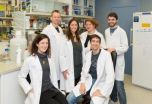(Press-News.org) A specialized subset of lung cells can shake flu infection, yet they remain stamped with an inflammatory gene signature that wreaks havoc in the lung, according to a study published in The Journal of Experimental Medicine.
Seasonal flu is caused by influenza virus, which can infect a variety of cell types in the lung. Infected cells are typically destroyed by the virus itself or by immune cells that attack infected cells. The resulting inflammation can linger on long after the virus has been eliminated leading to persistent symptoms and, in some cases, severe tissue damage.
Club cells are specialized cells that normally protect against inhaled microbes and pollutants. However, researchers from the Icahn School of Medicine at Mount Sinai in New York show that club cells are bad guys during flu infection. Although they are able to rid themselves of the flu virus, club cells fail to switch off expression of inflammatory genes causing prolonged pathology in the lungs even after the virus has been contained. Depletion of surviving club cells lessened destructive lung damage in flu-infected mice.
The authors confirm that human club cells show a similar inflammatory response to flu infection, so targeting club cells might be a strategy to shorten the duration of flu symptoms in humans.
INFORMATION:
Heaton, N.S., et al. 2014. J. Exp. Med. doi:10.1084/jem.20140488
About The Journal of Experimental Medicine
The Journal of Experimental Medicine (JEM) is published by The Rockefeller University Press. All editorial decisions on manuscripts submitted are made by active scientists in conjunction with our in-house scientific editors. JEM content is posted to PubMed Central, where it is available to the public for free six months after publication. Authors retain copyright of their published works and third parties may reuse the content for non-commercial purposes under a creative commons license. For more information, please visit http://www.jem.org .
Research reported in the press release was supported by the Research Training Program in Molecular and Cellular Hematology, the Centers for Excellence for Influenza Research and Surveillance, and the National Institutes of Health.
Club cells are 'bad guys' during flu infection
Targeting club cells might be a way to shorten the duration of flu symptoms
2014-08-18
ELSE PRESS RELEASES FROM THIS DATE:
Myc inhibition is an effective therapeutic strategy against most aggressive brain tumors
2014-08-18
Barcelona, 18 August 2014. Research led by the Vall d'Hebron Institute of Oncology (VHIO) evidence the most conclusive preclinical results to-date validating Myc inhibition as a therapeutic strategy in glioma – a highly agressive tumor type that notoriously outsmarts current anti-cancer therapies. The study led by Laura Soucek, Principal Investigator of VHIO´s Mouse Models of Cancer Therapies Group, published today in Nature Communications, not only represents an important step forward in ultimately providing brain glioma patients with new therapeutic avenues, but also ...
Sun's activity influences natural climate change
2014-08-18
For the first time, a research team has been able to reconstruct the solar activity at the end of the last ice age, around 20,000-10,000 years ago, by analysing trace elements in ice cores in Greenland and cave formations from China. During the last glacial maximum, Sweden was covered in a thick ice sheet that stretched all the way down to northern Germany and sea levels were more than 100 metres lower than they are today, because the water was frozen in the extensive ice caps. The new study shows that the sun's variation influences the climate in a similar way regardless ...
Antibiotics in early life may alter immunity long-term
2014-08-18
New University of British Columbia research found that receiving antibiotic treatments early in life can increase susceptibility to specific diseases later on.
Most bacteria living in the gut play a positive role in promoting a healthy immune system, but antibiotic treatments often do not discriminate between good and bad bacteria. The study published today in Journal of Allergy and Clinical Immunology helps scientists understand how different antibiotics affect good bacteria.
"This is the first step to understanding which bacteria are absolutely necessary to develop ...
Promising ferroelectric materials suffer from unexpected electric polarizations
2014-08-18
UPTON, NY—Electronic devices with unprecedented efficiency and data storage may someday run on ferroelectrics—remarkable materials that use built-in electric polarizations to read and write digital information, outperforming the magnets inside most popular data-driven technology. But ferroelectrics must first overcome a few key stumbling blocks, including a curious habit of "forgetting" stored data.
Now, scientists at the U.S. Department of Energy's Brookhaven National Laboratory have discovered nanoscale asymmetries and charge preferences hidden within ferroelectrics ...
International scientific team criticizes adoption of 'novel ecosystems' by policymakers
2014-08-18
Embracing "novel" ecosystems is dangerous, according to a new study by an international team.
Novel ecosystems arise when human activities transform biological communities through species invasions and environmental change. They are seemingly ubiquitous, and thus many policymakers and ecologists argue for them to be accepted as the "new normal"—an idea the researchers say is a bad one.
In the study, published in the September edition of the academic journal Trends in Ecology and Evolution, the international team argues that adopting novel ecosystems is based on faulty, ...
Visual 'gist' helps us figure out where a crowd is looking
2014-08-18
Have you ever seen a crowd of people looking off into the distance, perhaps toward a passing biker or up to the top of a building? There's a good chance you looked there, too, instantly, even without paying attention to the individuals in the group. How can we tell where a crowd is looking with so little effort?
Researchers at the University of California, Berkeley and the University of Denver have discovered that we rely on a specialized visual process known as "ensemble coding" to perceive where a crowd is looking. Their new study shows that we are able to tell where ...
Prioritizing suicide research can help lead to fewer suicide attempts and deaths
2014-08-18
Ann Arbor, MI, August 18, 2014 – In a new supplement to the September issue of the American Journal of Preventive Medicine, experts address the state of the science on suicide prevention and provide useful recommendations for research to inform effective suicide prevention. Suicide has been a challenging and perplexing public health issue to study as it has many dimensions and underlying factors. Although much is known about the patterns and potential risk factors of suicide, the national suicide rate does not appear to have dropped over the last 50 years.
This groundbreaking ...
IU study: Parents' vaccine intentions influenced by how benefits are communicated
2014-08-18
INDIANAPOLIS -- How do parents decide whether to vaccinate their child? In a study designed to formally look at the content of parent-targeted communications about the benefits of vaccination for measles, mumps and rubella, Indiana University School of Medicine investigators report that the framing of these messages influences parents' intentions to immunize their children.
The investigators report that parents who viewed informational material highlighting direct benefits to their own child were the most likely to subsequently indicate that they would have their baby ...
White, straight women leading surge in infertility treatments
2014-08-18
WASHINGTON — Heterosexual white women are twice as likely as racial or sexual minority women to obtain medical help to get pregnant, according to a recent study published by the American Psychological Association.
While income and lack of insurance only partially explained the lower number of racial minority women receiving fertility assistance, lack of insurance appeared to play a crucial role in whether lesbian and bisexual women received medical fertility help, especially in more recent years, according to the nationally representative study published in the APA journal ...
Environment and health experts commit to actions on climate change
2014-08-18
MONTREAL, August 15, 2014 — More than 500 delegates to the EcoHealth 2014 conference have issued a call to action to urgently and collaboratively address the impacts of climate change on the health of humans, animals and the global environment in light of the lack of a truly collective response to date.
Working through the International Association for Ecology and Health (IAEH), the 500 delegates from 62 countries, and the larger ecohealth community they reflect, have developed a vision and commitment to action that will bring together what is already being done to address ...
LAST 30 PRESS RELEASES:
Numbers in our sights affect how we perceive space
SIMJ announces global collaborative book project in commemoration of its 75th anniversary
Air pollution exposure and birth weight
Obstructive sleep apnea risk and mental health conditions among older adults
How talking slows eye movements behind the wheel
The Ceramic Society of Japan’s Oxoate Ceramics Research Association launches new international book project
Heart-brain connection: international study reveals the role of the vagus nerve in keeping the heart young
Researchers identify Rb1 as a predictive biomarker for a new therapeutic strategy in some breast cancers
Survey reveals ethical gaps slowing AI adoption in pediatric surgery
Stimulant ADHD medications work differently than thought
AI overestimates how smart people are, according to HSE economists
HSE researchers create genome-wide map of quadruplexes
Scientists boost cell "powerhouses" to burn more calories
Automatic label checking: The missing step in making reliable medical AI
Low daily alcohol intake linked to 50% heightened mouth cancer risk in India
American Meteorological Society announces Rick Spinrad as 2026 President-Elect
Biomass-based carbon capture spotlighted in newly released global climate webinar recording
Illuminating invisible nano pollutants: advanced bioimaging tracks the full journey of emerging nanoscale contaminants in living systems
How does age affect recovery from spinal cord injury?
Novel AI tool offers prognosis for patients with head and neck cancer
Fathers’ microplastic exposure tied to their children’s metabolic problems
Research validates laboratory model for studying high-grade serous ovarian cancer
SIR 2026 delivers transformative breakthroughs in minimally invasive medicine to improve patient care
Stem Cell Reports most downloaded papers of 2025 highlight the breadth and impact of stem cell research
Oxford-led study estimates NHS spends around 3% of its primary and secondary care budget on the health impacts of heat and cold in England
A researcher’s long quest leads to a smart composite breakthrough
Urban wild bees act as “microbial sensors” of city health.
New study finds where you live affects recovery after a hip fracture
Forecasting the impact of fully automated vehicle adoption on US road traffic injuries
Alcohol-related hospitalizations from 2016 to 2022
[Press-News.org] Club cells are 'bad guys' during flu infectionTargeting club cells might be a way to shorten the duration of flu symptoms




